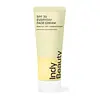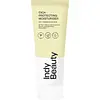What's inside
What's inside
 Key Ingredients
Key Ingredients

 Benefits
Benefits

 Concerns
Concerns

 Ingredients Side-by-side
Ingredients Side-by-side

Water
Skin ConditioningPEG-6 Stearate
EmulsifyingEthylhexyl Methoxycinnamate
UV AbsorberIsononyl Isononanoate
EmollientButyl Methoxydibenzoylmethane
UV AbsorberEthylhexyl Salicylate
UV AbsorberGlyceryl Stearate
EmollientOctocrylene
UV AbsorberGlycol Stearate
EmollientPEG-32 Stearate
EmulsifyingMethylene Bis-Benzotriazolyl Tetramethylbutylphenol
UV FilterGlycerin
HumectantPhenoxyethanol
PreservativeCaprylyl Glycol
EmollientHydroxyethyl Acrylate/Sodium Acryloyldimethyl Taurate Copolymer
Emulsion StabilisingCetyl Palmitate
EmollientXanthan Gum
EmulsifyingPolyisobutene
Decyl Glucoside
CleansingDisodium EDTA
Tocopheryl Acetate
AntioxidantPEG-7 Trimethylolpropane Coconut Ether
EmulsifyingSorbitan Isostearate
EmulsifyingPropylene Glycol
HumectantWater, PEG-6 Stearate, Ethylhexyl Methoxycinnamate, Isononyl Isononanoate, Butyl Methoxydibenzoylmethane, Ethylhexyl Salicylate, Glyceryl Stearate, Octocrylene, Glycol Stearate, PEG-32 Stearate, Methylene Bis-Benzotriazolyl Tetramethylbutylphenol, Glycerin, Phenoxyethanol, Caprylyl Glycol, Hydroxyethyl Acrylate/Sodium Acryloyldimethyl Taurate Copolymer, Cetyl Palmitate, Xanthan Gum, Polyisobutene, Decyl Glucoside, Disodium EDTA, Tocopheryl Acetate, PEG-7 Trimethylolpropane Coconut Ether, Sorbitan Isostearate, Propylene Glycol
Water
Skin ConditioningC15-19 Alkane
SolventBis-Ethylhexyloxyphenol Methoxyphenyl Triazine
Skin ConditioningDiethylamino Hydroxybenzoyl Hexyl Benzoate
UV FilterEthylhexyl Salicylate
UV AbsorberEthylhexyl Triazone
UV AbsorberDicaprylyl Ether
EmollientPolymethyl Methacrylate
Glycerin
HumectantCetearyl Alcohol
EmollientNiacinamide
SmoothingSqualane
EmollientSynthetic Fluorphlogopite
Disodium Cetearyl Sulfosuccinate
CleansingGlyceryl Stearate
EmollientCentella Asiatica Leaf Extract
Skin ConditioningSodium Hyaluronate
HumectantPanthenol
Skin ConditioningAllantoin
Skin ConditioningPantolactone
HumectantTocopheryl Acetate
AntioxidantButylene Glycol
HumectantTocopherol
AntioxidantSqualene
EmollientGlycine Soja Oil
EmollientBeta-Sitosterol
Emulsion StabilisingXanthan Gum
EmulsifyingAminomethyl Propanol
BufferingLauroyl Lysine
Skin ConditioningCaprylyl Glycol
EmollientCitric Acid
BufferingSodium Laureth Sulfate
CleansingPhenoxyethanol
PreservativeWater, C15-19 Alkane, Bis-Ethylhexyloxyphenol Methoxyphenyl Triazine, Diethylamino Hydroxybenzoyl Hexyl Benzoate, Ethylhexyl Salicylate, Ethylhexyl Triazone, Dicaprylyl Ether, Polymethyl Methacrylate, Glycerin, Cetearyl Alcohol, Niacinamide, Squalane, Synthetic Fluorphlogopite, Disodium Cetearyl Sulfosuccinate, Glyceryl Stearate, Centella Asiatica Leaf Extract, Sodium Hyaluronate, Panthenol, Allantoin, Pantolactone, Tocopheryl Acetate, Butylene Glycol, Tocopherol, Squalene, Glycine Soja Oil, Beta-Sitosterol, Xanthan Gum, Aminomethyl Propanol, Lauroyl Lysine, Caprylyl Glycol, Citric Acid, Sodium Laureth Sulfate, Phenoxyethanol
Ingredients Explained
These ingredients are found in both products.
Ingredients higher up in an ingredient list are typically present in a larger amount.
Caprylyl Glycol is a humectant and emollient, meaning it attracts and preserves moisture.
It is a common ingredient in many products, especially those designed to hydrate skin. The primary benefits are retaining moisture, skin softening, and promoting a healthy skin barrier.
Though Caprylyl Glycol is an alcohol derived from fatty acids, it is not the kind that can dry out skin.
This ingredient is also used as a preservative to extend the life of products. It has slight antimicrobial properties.
Learn more about Caprylyl GlycolEthylhexyl Salicylate is an organic compound used to block UV rays. It primarily absorbs UVB rays but offers a small amount of UVA protection as well.
Commonly found in sunscreens, Ethylhexyl Salicylate is created from salicylic acid and 2-ethylhexanol. You might know salicylic acid as the effective acne fighter ingredient and BHA.
The ethylhexanol in this ingredient is a fatty alcohol and helps hydrate your skin, similar to oils. It is an emollient, which means it traps moisture into the skin.
According to manufacturers, Ethylhexyl Salicylate absorbs UV wavelength of 295-315 nm, with a peak absorption at 307-310 nm. UVA rays are linked to long term skin damage, such as hyperpigmentation. UVB rays emit more energy and are capable of damaging our DNA. UVB rays cause sunburn.
Learn more about Ethylhexyl SalicylateGlycerin is already naturally found in your skin. It helps moisturize and protect your skin.
A study from 2016 found glycerin to be more effective as a humectant than AHAs and hyaluronic acid.
As a humectant, it helps the skin stay hydrated by pulling moisture to your skin. The low molecular weight of glycerin allows it to pull moisture into the deeper layers of your skin.
Hydrated skin improves your skin barrier; Your skin barrier helps protect against irritants and bacteria.
Glycerin has also been found to have antimicrobial and antiviral properties. Due to these properties, glycerin is often used in wound and burn treatments.
In cosmetics, glycerin is usually derived from plants such as soybean or palm. However, it can also be sourced from animals, such as tallow or animal fat.
This ingredient is organic, colorless, odorless, and non-toxic.
Glycerin is the name for this ingredient in American English. British English uses Glycerol/Glycerine.
Learn more about GlycerinGlyceryl Stearate is a mix of glycerin and stearic acid.
It is used to stabilize the mixing of water and oil ingredients. By preventing these ingredients from separating, it can help elongate shelf life. It can also help thicken the product's texture.
As an emollient, it helps soften skin and supports barrier-replenishing ingredients.
In cosmetics, Glyceryl Stearate is often made from vegetable oils or synthetically produced.
This ingredient may not be fungal-acne safe
Fun fact: The human body also creates Glyceryl Stearate naturally.
Learn more about Glyceryl StearatePhenoxyethanol is a preservative that has germicide, antimicrobial, and aromatic properties. Studies show that phenoxyethanol can prevent microbial growth. By itself, it has a scent that is similar to that of a rose.
It's often used in formulations along with Caprylyl Glycol to preserve the shelf life of products.
Tocopheryl Acetate is AKA Vitamin E. It is an antioxidant and protects your skin from free radicals. Free radicals damage the skin by breaking down collagen.
One study found using Tocopheryl Acetate with Vitamin C decreased the number of sunburned cells.
Tocopheryl Acetate is commonly found in both skincare and dietary supplements.
Learn more about Tocopheryl AcetateWater. It's the most common cosmetic ingredient of all. You'll usually see it at the top of ingredient lists, meaning that it makes up the largest part of the product.
So why is it so popular? Water most often acts as a solvent - this means that it helps dissolve other ingredients into the formulation.
You'll also recognize water as that liquid we all need to stay alive. If you see this, drink a glass of water. Stay hydrated!
Learn more about WaterXanthan gum is used as a stabilizer and thickener within cosmetic products. It helps give products a sticky, thick feeling - preventing them from being too runny.
On the technical side of things, xanthan gum is a polysaccharide - a combination consisting of multiple sugar molecules bonded together.
Xanthan gum is a pretty common and great ingredient. It is a natural, non-toxic, non-irritating ingredient that is also commonly used in food products.
Learn more about Xanthan Gum